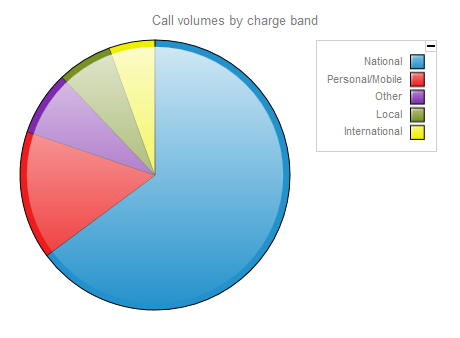The Summary Graphs panel consists of three separate graphs, each of them organising their information using different criteria, enabling you to see at-a-glance the overall performance of your entire organisation.
The three graphs display the following information:

Call volume by call type
This first graph shows a snapshot of calls made and received so far today, based on the type of call, e.g. inbound, outbound, missed.
Each call type is colour-coded using a system-wide colour scheme as follows:
- Green: Incoming calls
- Light green: Answered transferred calls
- Blue: Outgoing calls
- Light blue: Outgoing non-connected calls
- Grey: Internal calls
- Mauve: Internal non-connected calls
- Red: Abandoned DDI (Direct Dialled In) calls
- Pink: Tandem calls
The same call type colour coding system applies throughout TIM Plus. |
Call volume by half hour
This graph shows a snapshot of the day's calls broken down by half-hour, allowing you to quickly identify peaks and troughs in call volumes to identify busy periods.

Each call type is colour-coded using a system-wide colour scheme as follows:
- Green: Incoming calls
- Light green: Answered transferred calls
- Blue: Outgoing calls
- Light blue: Outgoing non-connected calls
- Grey: Internal calls
- Mauve: Internal non-connected calls
- Red: Abandoned DDI (Direct Dialled In) calls
- Pink: Tandem calls
Call volume by charge band
This graph shows a snapshot of today's calls based on their destination, allowing you to identify where you call most often. Calls are grouped into geographical locations such as Mobile, National, Local, International etc.

By default, the following colour scheme is used to identify calls to each geographical group:
- Red: Personal/Mobile calls
- Green: Local calls
- Blue: National calls
- Yellow: International calls
- Purple: Other calls